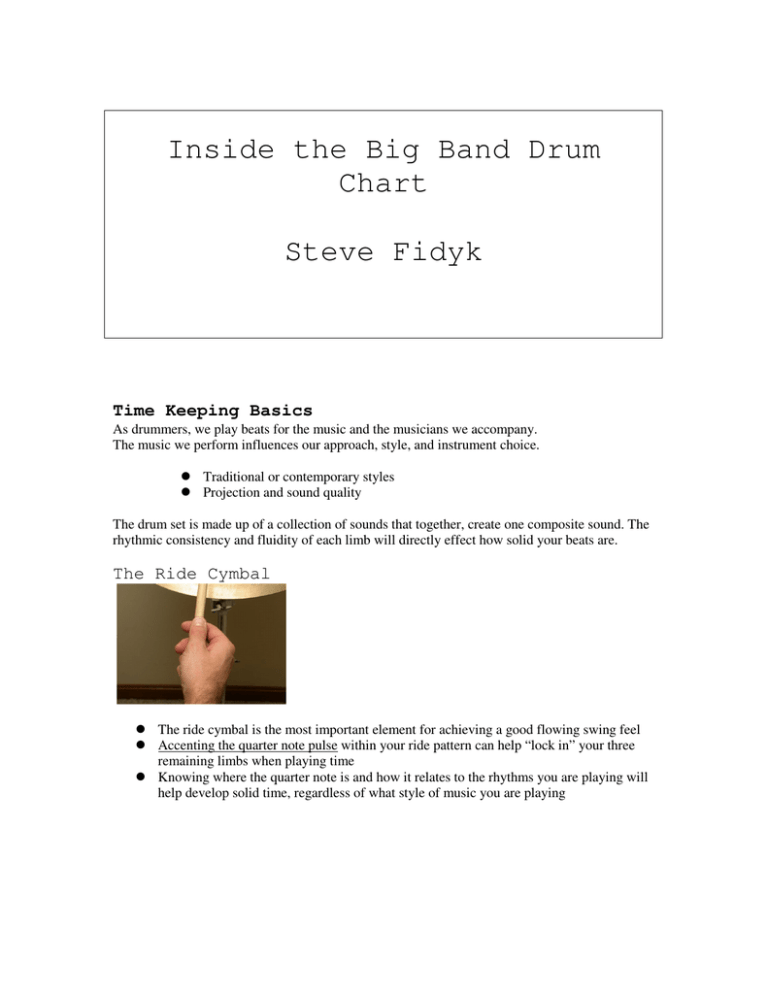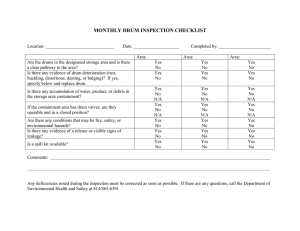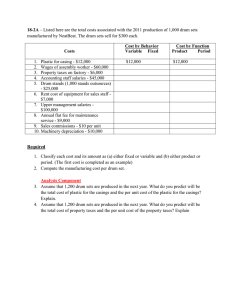Inside the Big Band Drum Chart Steve Fidyk
advertisement

Inside the Big Band Drum Chart Steve Fidyk Time Keeping Basics As drummers, we play beats for the music and the musicians we accompany. The music we perform influences our approach, style, and instrument choice. Traditional or contemporary styles Projection and sound quality The drum set is made up of a collection of sounds that together, create one composite sound. The rhythmic consistency and fluidity of each limb will directly effect how solid your beats are. The Ride Cymbal The ride cymbal is the most important element for achieving a good flowing swing feel Accenting the quarter note pulse within your ride pattern can help “lock in” your three remaining limbs when playing time Knowing where the quarter note is and how it relates to the rhythms you are playing will help develop solid time, regardless of what style of music you are playing The Bass Drum The bass drum is the foundation of your swing feel It can be used to keep time by feathering four quarter notes to the measure, or used for accenting rhythms played by the rhythm section and ensemble The Hi Hat The hi hat can function as a timekeeper, or for accenting beats two and four of your ride cymbal pattern In addition to the standard two and four rhythm, the hi hat can be used for accenting to produce variations in your swing feel Chart Reading Fundamentals There is not a standardized method that arrangers use for writing drum parts. Some composers give exact information concerning style, tempo, ensemble or section accents, and suggested beats for certain sections of a chart. I’ve also read arrangements that provided nothing more than the name of the composition followed by numerous measures of repeat signs. Because a drum chart does not accurately represent what you play, it is essentially a guide that drummers use to improvise and compose an individual part. This is the greatest difference between brass or reed parts and a drum part. Another point of contention is most arrangers are not drummers and often have difficulty communicating exactly what they expect from you on the part. One suggestion would be to question what you see and listen carefully as you read. Listen for the ensembles phrasing (swung or straight), articulations (long or short), and dynamics (loud or soft) and use this information to help compose appropriate beats and figure interpretation. Your personal interpretation of the music should reflect the amount of detail found within the arrangement itself. Listen for: The introduction, melody, solos and background figures, shout choruses, key changes, etc. Interpreting the music with this approach can help bring about a more effective accompaniment plan. Engage the listener with ideas that have variety and contrast as you lead the ensemble through each musical phrase. One example of this is when a musical theme ascends from a low register to a higher one, try playing the phrase by ascending from your low drum (bass drum or floor tom), to a higher voice (possibly snare drum or hi hat). The written phrase on your drum part will not reflect any shape. Try consulting the lead trumpet part to discover the shape of any musical line. Articulation As drummers, we cannot play note durations with the accuracy of a horn player, but we can designate sound sources from the drum set that best complement the articulation and intensity of a note or phrase. A note’s articulation is determined by: a. what section of the band is playing b. the intensity of the phrase c. the instrument range (high or low) the phrase is played The key is to let your ears point you in the right musical direction. Your approach to phrasing and articulating should always complement the ensemble, and by reading and understanding these symbols, you will bring clarity to the longer phrases you play. Below is a trumpet 1 phrase with articulation marks. If we expose the rhythms with articulations, we have a phrase that illustrates the emphasized horn rhythms. These are destination points in a musical line that create a second tier of accent texture. With just the articulated rhythm, the phrase looks like this: Below is one common drum set articulation for this phrase. By reading and emphasizing the articulated rhythm, you naturally attain the notes a horn player would give significance to. Now you are phrasing and articulating with the band!! Dynamic Expression and Shape Music of all styles or genres has shape. As a piece of music develops, phrases ascend or descend with intensity creating different musical textures and moods. Drum parts from big band arrangements have a multitude of single “flat line” rhythms that do not indicate shape. It is up to the individual performer to interpret these rhythms around the drum set. Flat line drum set section figure example: Below are the same two measures from the trumpet one part: The line drawing below approximates the shape of the above multiple note trumpet figure. You can apply this shape on the drums and cymbals. Set Up the Band! A “set up” is an improvised fill that helps prepare a section or ensemble entrance enhancing the flow and excitement of the arrangement. Set ups are determined in part by the tempo and style of the piece and can complement or contrast its parent band figure rhythmically or dynamically. On the following page is a 4 measure phrase followed by various set up approaches at different tempos: At a slow tempo, smaller subdivisions such as eighth note triplets or sixteenth notes can be used as set up material. A faster tempo requires less rhythmic fill activity. Now let’s look at each phrase side by side for analysis purposes. a. b. e. c. f. g. d. h. i. j. k. Example 1 Analysis/84 beats per minute a. This is an example of parallel motion. The triplet fill leads the ensemble to their entrance. The figure is then played in unison with the horns. The drums and horns move parallel to one another. b. Example B creates counter point. By accenting beat one of measure two, the drum fill produces a new rhythmic figure. The ensemble rhythm on beat two is not played in unison. The ensemble enters on beat two. c. This is another example of parallel motion with sixteenth note set up fills. d. Because the tempo is slow, example D illustrates figures with eighth note triplet connector material. Example 2 Analysis/138 beats per minute e. parallel motion figure treatment with eighth notes f. counter point example with quarter notes creating new accents on: (beat four, measure two), and (beat one, measure three) g. parallel motion with triplet fills h. eighth notes played as connector material Example 3 Analysis/260 beats per minute i. eighth note connector material j. parallel motion with a quarter note fill set up k. eighth notes played as connector material I hope this material serves as a guide to help develop jazz band drumming reading and interpretation skills for you and your students. If you have any questions concerning this presentation, please email me directly at stevefid@comcast.net The excerpts in this handout are from Inside the Big Band Drum Chart by Steve Fidyk. © 2008 Mel Bay Publications, Inc. All rights reserved. Used with Permission.


